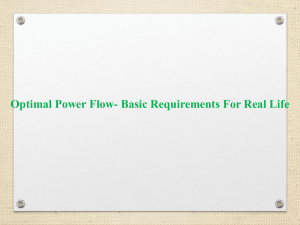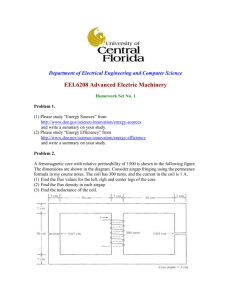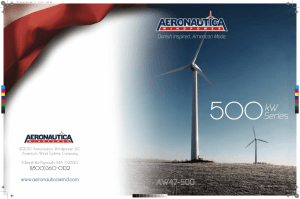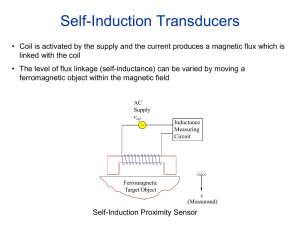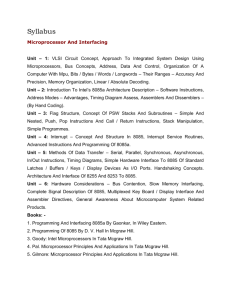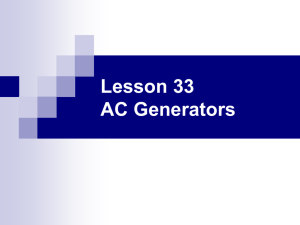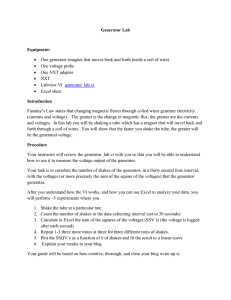File
advertisement
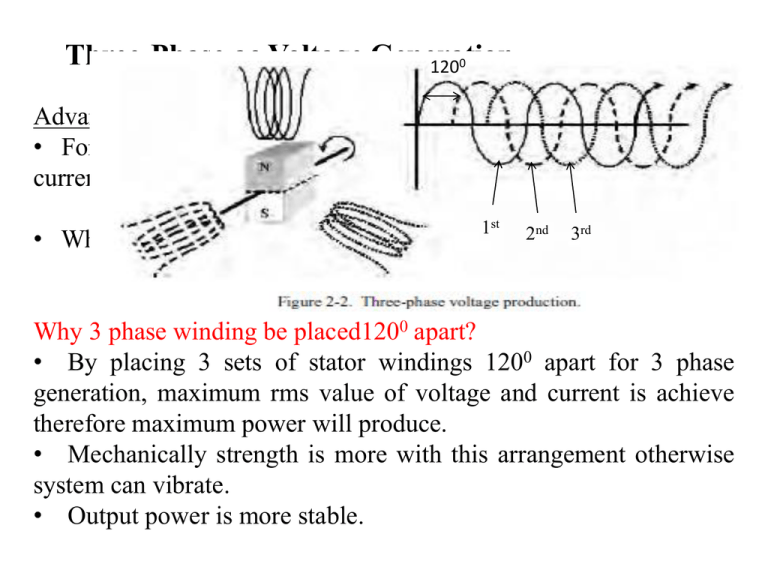
Three-Phase ac Voltage Generation 1200 Advantages: • For single phase power is rms value of voltage multiplied by current. P Vrms I rms 1st • Whereas 3 phase provide 73% more power nd rd 2 3 than single phase. P Vrms I rms 3 Why 3 phase winding be placed1200 apart? • By placing 3 sets of stator windings 1200 apart for 3 phase generation, maximum rms value of voltage and current is achieve therefore maximum power will produce. • Mechanically strength is more with this arrangement otherwise system can vibrate. • Output power is more stable. Three-Phase AC Voltage Generation There are two methods of 3 phase AC generation using synchronous generator: 1. Permanent magnet SG 2. Electromagnet SG • A permanent magnet synchronous generator is a generator where the excitation field is provided by a permanent magnet instead of a coil. • Synchronous means that the generator’s rotor runs at the ‘constant’ mains frequency as load varies. • Synchronous generators are the majority source of commercial electrical energy. • They are commonly used to convert the mechanical power output of steam turbines, gas turbines, reciprocating engines, hydro turbines and wind turbines into electrical power for the grid. AC Voltage Generation using PMSG Stator Windings Permanent Magnet Rotor Three-Phase AC Voltage Generation…… • Second type of generator use electromagnets to produce a magnetic field in a rotor winding. • The direct current in the rotor field winding is fed through a slip-ring assembly. • Permanent magnet generators do not require a DC supply for the excitation circuit, nor do they have slip rings. Prime Mover AC Voltage Generation …….. The Exciter • The voltage source for the rotor, which eventually creates the rotor’s magnetic field, is called the exciter, and the coil on the rotor is called the field. • Most generators use slip rings to complete the circuit between the stationary exciter voltage source and the rotating coil on the rotor where the electromagnet produces the north and south poles. AC Voltage Generation …….. AC Voltage Generation …….. Disadvantage of PMSG • However, large permanent magnets are costly which restricts the economic rating of the machine. • The flux density of high performance permanent magnets is limited. The air gap flux is not controllable, so the voltage of the machine cannot be easily regulated. • High performance permanent magnets, themselves, have structural and thermal issues. AC Voltage Generation …….. Issues related to rotor speed • When load is added to a generator’s stator windings reduces rotor speed because of the repelling forces between the stator’s magnetic field, and the rotor’s magnetic field since both windings have electrical current flowing through them. • Conversely, removing load from a generator increases rotor speed. Therefore, the mechanical energy of the prime mover that is responsible for spinning the rotor must be adjusted to maintain rotor speed or frequency under varying load conditions. AC Voltage Generation …….. Rotor Poles • Increasing the number of magnetic poles on the rotor enables rotor speeds to be slower and therefore maintain the same electrical output frequency. • Generators that require slower rotor speeds to operate properly use multiple-pole rotors. For example, hydropower plants use generators with multiple-pole rotors because the prime mover (i.e., water) is very dense and harder to control than light-weight steam. AC Voltage Generation …….. • The relationship between the number of poles on the rotor and the frequency of the rotor is determined using the following mathematical formula: pnm f 120 Where f = frequency of the induced voltage (Hz) p = number of poles on the rotor nm = speed of the rotor (rpm) • The equation relationship between the induced voltage (rms) in a winding around a ferromagnetic core carrying a sinusoidal magnetic flux density was found to be V 4.44NfBMAXA Where BMAX = Peak value of the magnetic flux density A = Cross-sectional area of the core AC Voltage Generation …….. Real time AC Voltage Generation • Power plants produce electrical energy on a real-time basis. • Electric power systems do not store energy such as gas or water systems do. For example, when a toaster is switched on and drawing electrical energy from the system, the associated generating plants immediately see this as new load and slightly slow down. • As more and more load (i.e., toasters, lights, motors, etc.) are switched on, generation output and prime mover rotational shaft energy must be increased to balance the load demand on the system. Electrical generation always produces electricity on an “as needed” basis Generator Connections • There are two ways to connect three windings that have a total of six leads (the ends of the winding wires) symmetrically. • The two symmetrical connection configurations of a threephase generator (or motor) are called delta and wye. • Generators stator windings connected internally in either a delta or wye configuration. Generator Connections…… Delta • Delta configurations have all three windings connected in series. The phase leads are connected to the three common points where windings are joined. Wye • The wye configuration connects one lead from each winding to form a common point called the neutral. • The other three phase leads are brought out of the generator separately for external system connections. • The neutral is often grounded to the station ground grid for voltage reference and stability. Wye and delta Stator Connections • Electric power plant generators use either wye or delta connections. • The phase leads from the generator are connected to the plant’s step-up transformer where the generator output voltage is increased significantly to transmission voltage levels for the efficient transportation of electrical energy. Wye Connected Generator Delta Connected Generator Power Plants and Prime Movers • Power generation plants produce the electrical energy that is ultimately delivered to consumers through transmission lines, substations, and distribution lines. • Generation plants or power plants consist of following things: 1. 2. 3. 4. 5. Three-phase generator(s) The prime mover Energy source Control room Substation already discussed Prime Mover • The mechanical means of turning the generator’s rotor is called the prime mover. • The prime mover’s energy sources include the conversion process of raw fuel, such as coal, to the end product—steam—that will turn the turbine. • The bulk of electrical energy produced in today’s interconnected power systems is normally produced through a conversion process from coal, oil, natural gas, nuclear, and hydro. • Electrical power is produced from wind, solar, geothermal, and biomass energy resources. Prime Mover…….. • The more common types of energy resources used to generate electricity and their associated prime movers include: Steam turbines 1. Fossil fuels (coal, gas, oil) 2. Nuclear 3. Geothermal 4. Solar-heated steam Hydro turbines 1. Dams and rivers 2. Pump storage Combustion turbines 1. Diesel 2. Natural gas 3. Combined cycle Wind turbines Solar direct (photovoltaic) First Assignment


